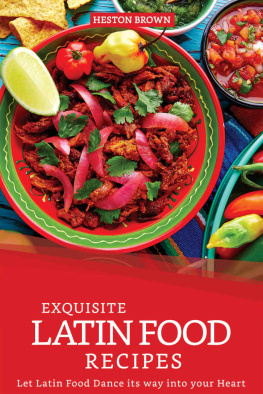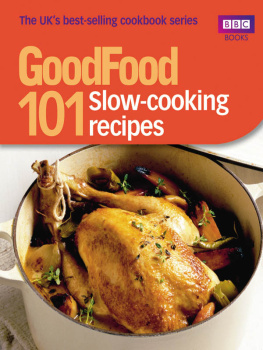Table of Contents
Curiosity is a willing, a proud, an eager confession of ignorance.
Lets get one thing straight right up front. I still am not a chef. I dont have much interest in creating tantalizing new dishes, which is a good thing because I dont have the talent for it. What I am interested in is making food make sense. And food that makes sense (if that makes any sense). I want to understand what makes food tick and how to control the process known as cooking. In that regard Im more a mechanic than a cook.
In the bigger scheme Im a student, which is ironic since I spent seventeen years as one of the worst students in the history of public education. The reason I barely made it out of high school and wasted the better part of a decade in college is that most of the classesbiology, math, history, and chemistryjust didnt mean anything to me. I couldnt relate to the garble of formulas, equations, dates, and... stuff. Now, through the miracle of modern food tinkering, things are starting to make sense to me. After all, food is about nothing if not chemistry, physics, math, biology, botany, history, geography, and anthropologywith a little epidemiology thrown in for good measure. Yes, there are still formulas and equations and even a symbol or twobut now I think theyre kind of cool. And the best part is that it all leads to dinner.
Of course the more I learn, the more I realize I need to know. At some point, I hope to learn enough to realize that I know nothing at all. Then maybe Ill be able to snatch a pebble from Julia Childs hand.

A Mission-of Sorts
If I could choose to have any job title, it would be culinary cartographer.
Lets say I invite you to lunch. Youve never been to my house so you ask for directions. I fax you a very precise list of instructions designed to get you where youre going. Distances are calculated to the tenth of a mile and landmarks are described in Proustian detail. You arrive without a hitch.
But do you know where you are? If a tree had fallen in the road or a road suddenly closed, would you know what to do? Unless you have a global positioning system in your pocket, Im eating lunch alone.
If only Id sent you a map instead.
This is whats wrong with recipes. Sure, they can get us where were going, but that doesnt mean we know where we are when we get there. And it would be a real shame to make it all the way to a souffl without realizing that scrambled eggs are just over the next hill and meringues just around the corner.
Do you have to know how to scramble an egg before you can make a souffl or how to sear a steak to make a beef stew? No. A halfway decent recipe can get you to either of those destinations. But unless you understand where you are and how you got there, youre a hostage. And its hard to have fun when youre a hostage.
Of course, to gain the kind of knowledge Im talking about, we must start at the beginningthe very beginning:
Cook ( v. ) - to prepare food for eating by means of heat.
A car is not defined by CD changers, mud flaps, or leather upholstery. A car is defined by wheels, a chassis, and an engine. Likewise, cooking is not defined by seasonings, glazes, sauces, infusions, dusts, rubs, or relishes. It is defined by the application of heat. Since most of us live in a world where heat is conjured by the stroke of a switch or the twist of a knob, were not inclined to give it much thought.
That is unfortunate. Because until a cook (the noun, that is) comes to terms with the intricate tango of matter and energy that defines cooking, he or she will remain in a world of darkness and doubt.
Case in point: I recently dined at the home of a friend who must remain nameless lest I never get invited there again. The entre featured the breast of a free-range chicken encased in a nutty, herby crust and drizzled with a citrus reduction that hinted at Gewrtztraminer. Despite the fact that half a dozen different flavors had been invited to the party, they lacked any unity or leadership and thus could not cover the fact that there was not one drop of moisture left in the meat. Were I a Fletcherite, Id have been there all night.
When I asked my hostess to share her inspiration for the dish, she enthusiastically presented a glossy food magazine in which a page was devoted to a picture of the dish and half a paragraph to the recipe, which included everything short of freeze-dried yak essence. And yet when it came to the engine and wheels, the skimpy instructions simply said salt to taste and cook 45 minutes or until done. Fashionably salt-fearing and unable to recognize done, my hostess had followed her recipe straight to oblivion. This sad end could have been sidestepped if only she had tempered her blind recipe faith with a dose of Baron von Rumohr, who wrote that there are three elements the cook must learn to control: salt , water, and (above all) heat .
This book is the result of my own desire to get the basics; to really understand why a steak that tastes great when seared is gross when boiled. Or why broccoli is better blanched than steamed. Or why brining is just about the best thing you can do to pork.
I know there are those who would say who cares? As long as I know how, why bother with why? I can only offer that for me, until I deal with the why, I dont really know the how... if you know what I mean.
This book is divided by cooking method rather than food type. Thats because when it comes to cooking, I think a mushroom has more in common with a steak than with vegetables. The recipes herein involve the application of heat to foods such as plants and animals. Foods that we ourselves manufacturesuch as batters, custards, and doughsare, alas, another book.
How to Read a Recipe
Before I had any actual cooking knowledge, I cooked from recipes. Unfortunately I treated them with the same lack of respect that I had for the instructions to countless model kits as a child. (Hey, I dont need anybody telling me what the Seaview looks like. I know what it looks like. You just glue this here and this here and and) I read recipes like a nine-year-old boy tearing through the instructions to a Ravel 1:20 scale model of an Apache attack helicopter he got for his birthday. As a result, I ruined quite a bit of food. But today, I know a better way.
Sit down in a comfortable chair and read through the ingredients list item by item and ascertain whether or not the required ingredients are indeed in-house. Nothings more frustrating than putting together that peach pie only to find that you arent in possession of peaches.
Now go through the parts list and note specifics like chopped, diced, crushed, cooked, drained, canned, fresh, and so on. Missing such details can lead to doom. Take a cup of black beans, for instance. Are they dry, soaked, cooked, cooked and drained, canned, or canned and drained? When added to a dish, each will render a different result.
Remain seated and read through the procedure as if it were a bedtime story. Those of you with children know what Im talking about. No matter how sure you are of the storyof its beginning, middle, and endyou cannot paraphrase, omit, improvise, or rush. It is your duty to read the story word for word... slowly. The same goes for recipes. You may have baked a cake before, or braised cabbage, or roasted a leg-o-beast, but that doesnt matter.
Do the instructions call for tools? If so, how specifically? A well-written recipe will be specific when it matters and general when it doesnt. If you lack particular gear, ponder substitutes. Generally speaking, pots and pans are exchangeable as long as the size (either dimension or volume) is close to the same. However, if a recipe calls for a non-stick pan, theres probably a good reason. Requests pertaining to glass or metal baking dishes should be heeded, as should those for the use of non-reactive vessels (see ). A whisk may be replaced by a hand mixer, though it usually doesnt work the other way around. A stick blender can often replace a bar blender, and a good food processor can often replace a chefs knife.












